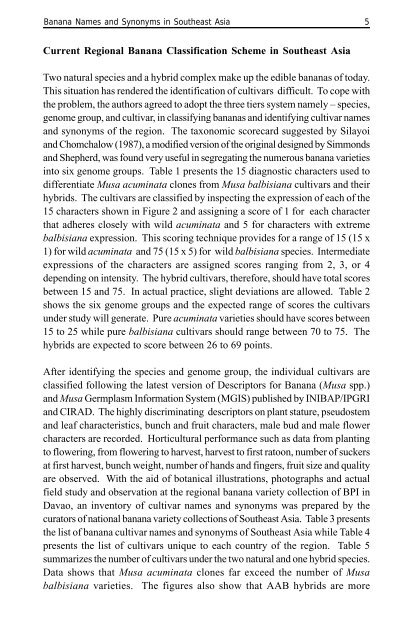Banana cultivar names and synonyms in Southeast Asia - Bioversity ...
Banana cultivar names and synonyms in Southeast Asia - Bioversity ...
Banana cultivar names and synonyms in Southeast Asia - Bioversity ...
You also want an ePaper? Increase the reach of your titles
YUMPU automatically turns print PDFs into web optimized ePapers that Google loves.
<strong>Banana</strong> Names <strong>and</strong> Synonyms <strong>in</strong> <strong>Southeast</strong> <strong>Asia</strong> 5<br />
Current Regional <strong>Banana</strong> Classification Scheme <strong>in</strong> <strong>Southeast</strong> <strong>Asia</strong><br />
Two natural species <strong>and</strong> a hybrid complex make up the edible bananas of today.<br />
This situation has rendered the identification of <strong>cultivar</strong>s difficult. To cope with<br />
the problem, the authors agreed to adopt the three tiers system namely – species,<br />
genome group, <strong>and</strong> <strong>cultivar</strong>, <strong>in</strong> classify<strong>in</strong>g bananas <strong>and</strong> identify<strong>in</strong>g <strong>cultivar</strong> <strong>names</strong><br />
<strong>and</strong> <strong>synonyms</strong> of the region. The taxonomic scorecard suggested by Silayoi<br />
<strong>and</strong> Chomchalow (1987), a modified version of the orig<strong>in</strong>al designed by Simmonds<br />
<strong>and</strong> Shepherd, was found very useful <strong>in</strong> segregat<strong>in</strong>g the numerous banana varieties<br />
<strong>in</strong>to six genome groups. Table 1 presents the 15 diagnostic characters used to<br />
differentiate Musa acum<strong>in</strong>ata clones from Musa balbisiana <strong>cultivar</strong>s <strong>and</strong> their<br />
hybrids. The <strong>cultivar</strong>s are classified by <strong>in</strong>spect<strong>in</strong>g the expression of each of the<br />
15 characters shown <strong>in</strong> Figure 2 <strong>and</strong> assign<strong>in</strong>g a score of 1 for each character<br />
that adheres closely with wild acum<strong>in</strong>ata <strong>and</strong> 5 for characters with extreme<br />
balbisiana expression. This scor<strong>in</strong>g technique provides for a range of 15 (15 x<br />
1) for wild acum<strong>in</strong>ata <strong>and</strong> 75 (15 x 5) for wild balbisiana species. Intermediate<br />
expressions of the characters are assigned scores rang<strong>in</strong>g from 2, 3, or 4<br />
depend<strong>in</strong>g on <strong>in</strong>tensity. The hybrid <strong>cultivar</strong>s, therefore, should have total scores<br />
between 15 <strong>and</strong> 75. In actual practice, slight deviations are allowed. Table 2<br />
shows the six genome groups <strong>and</strong> the expected range of scores the <strong>cultivar</strong>s<br />
under study will generate. Pure acum<strong>in</strong>ata varieties should have scores between<br />
15 to 25 while pure balbisiana <strong>cultivar</strong>s should range between 70 to 75. The<br />
hybrids are expected to score between 26 to 69 po<strong>in</strong>ts.<br />
After identify<strong>in</strong>g the species <strong>and</strong> genome group, the <strong>in</strong>dividual <strong>cultivar</strong>s are<br />
classified follow<strong>in</strong>g the latest version of Descriptors for <strong>Banana</strong> (Musa spp.)<br />
<strong>and</strong> Musa Germplasm Information System (MGIS) published by INIBAP/IPGRI<br />
<strong>and</strong> CIRAD. The highly discrim<strong>in</strong>at<strong>in</strong>g descriptors on plant stature, pseudostem<br />
<strong>and</strong> leaf characteristics, bunch <strong>and</strong> fruit characters, male bud <strong>and</strong> male flower<br />
characters are recorded. Horticultural performance such as data from plant<strong>in</strong>g<br />
to flower<strong>in</strong>g, from flower<strong>in</strong>g to harvest, harvest to first ratoon, number of suckers<br />
at first harvest, bunch weight, number of h<strong>and</strong>s <strong>and</strong> f<strong>in</strong>gers, fruit size <strong>and</strong> quality<br />
are observed. With the aid of botanical illustrations, photographs <strong>and</strong> actual<br />
field study <strong>and</strong> observation at the regional banana variety collection of BPI <strong>in</strong><br />
Davao, an <strong>in</strong>ventory of <strong>cultivar</strong> <strong>names</strong> <strong>and</strong> <strong>synonyms</strong> was prepared by the<br />
curators of national banana variety collections of <strong>Southeast</strong> <strong>Asia</strong>. Table 3 presents<br />
the list of banana <strong>cultivar</strong> <strong>names</strong> <strong>and</strong> <strong>synonyms</strong> of <strong>Southeast</strong> <strong>Asia</strong> while Table 4<br />
presents the list of <strong>cultivar</strong>s unique to each country of the region. Table 5<br />
summarizes the number of <strong>cultivar</strong>s under the two natural <strong>and</strong> one hybrid species.<br />
Data shows that Musa acum<strong>in</strong>ata clones far exceed the number of Musa<br />
balbisiana varieties. The figures also show that AAB hybrids are more

















